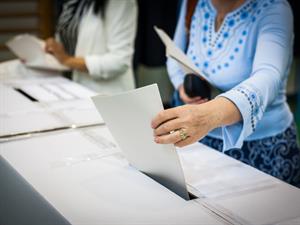PDF chapter test TRY NOW
Read the text.

Political Parties in the USA.
There are two major political parties, the Democratic Party and the Republican Party. Other parties have occasionally challenged these two but without permanent success. One reason for their failure is that in order to win a national election, a party must appeal to a broad base of voters and a wide spectrum of interests.
The two major parties thus tend to be moderate in their programs, and there may often be little difference between them on some issues. Each has a conservative wing, and each has a wing that is considered liberal. The conservative Democrats tend to be more conservative on racial issues, for example, than their Republican counterparts; the liberal Democrats are more radical on economic issues than the liberal Republicans.
The national parties contest presidential elections every four years. In elections for president and vice president, voters actually choose among electors committed to the support of a particular candidate, a system called the Electoral College. Each state is allotted one electoral vote for each senator and representative in Congress.
At the state level, political parties reflect the diversity of the population. Large urban centres are more likely to support a Democratic ticket, whereas rural areas, small cities and suburban areas tend more often to vote Republican. In many states rural areas and smaller towns control the state legislatures, even though the more populous city areas provide the greater proportion of tax revenue. A Supreme Court ruling in 1964 sought to remedy this situation by ordering states to reapportion their legislatures.
Some states have traditionally given majorities to one particular party. Until the mid-20th century, for example, the 11 Southern states of the old Confederacy voted almost solidly for Democratic candidates; in other states, such as Maine and South Dakota, Republicans are more likely to win. Municipal political parties have a pyramidal structure based, at the lowest level, on districts or precincts. The leaders of these units are responsible to ward leaders, who form the governing body of the municipal party. All of these party functionaries are responsible for getting their voters to the polls at election time, often on the basis of a return for services rendered. It is to them, after all, that voters have gone with requests for better municipal services, jobs and assistance in minor difficulties.
As society has become increasingly urban, politics and government have become more complex. Many problems of the cities, including the problems of transportation, housing, education, health and welfare, can no longer be handled entirely on the local level. Since even the states do not have the necessary resources, cities have often turned to the federal government for assistance.
Choose true or false:
1. The conservative Democrats tend to be more conservative on racial issues.
2. At the state level, political parties reflect the diversity of the population.
3. Cities have often turned to the federal government for assistance.
